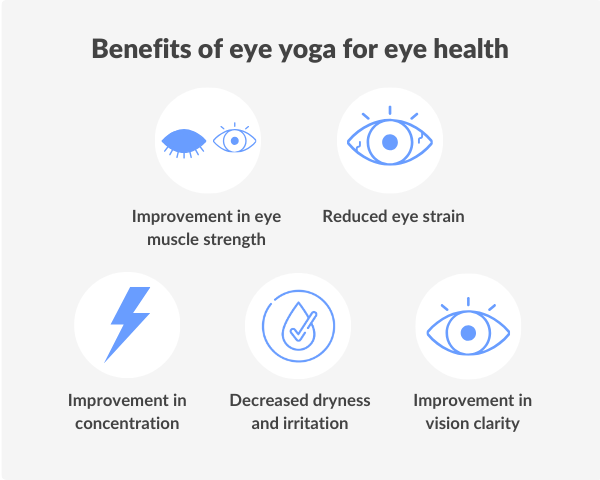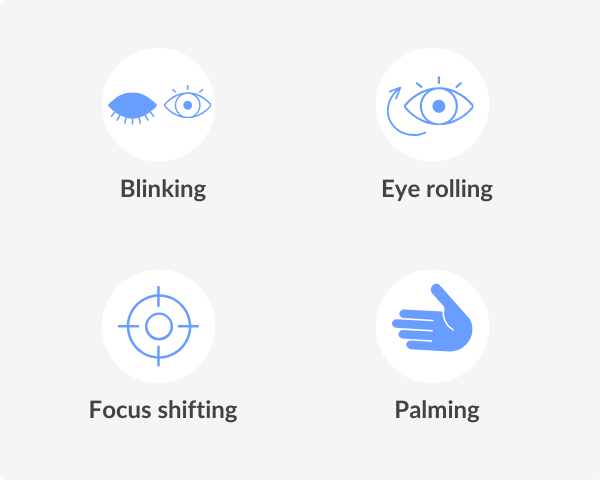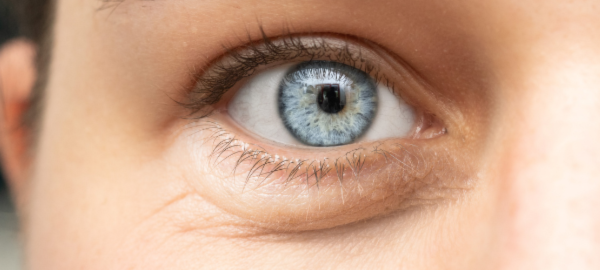Ask our dispensing optician
Your request was successfully submitted!
What Is Eye Yoga?

Reviewed by
Beck Jinnette
Please note: while eye yoga can be beneficial for alleviating eye strain and improving focus, there’s no scientific evidence that it can resolve or improve any vision conditions.
In today’s digital age, our eyes are under more strain than ever, leading to increased eye fatigue, dryness and discomfort.
Eye yoga can be a valuable, holistic way to help mitigate these symptoms. While reading the article, try the exercises to learn how they work!
This type of yoga specifically targets the ocular muscles (the muscles around the eye). It consists of exercises designed to strengthen the eye muscles, improve focus and promote relaxation.
Benefits of eye yoga
No scientific proof supports that eye yoga can help improve vision conditions like astigmatism, myopia, or presbyopia (Bianchi and Bellen 2020).
However, there is evidence that eye yoga might be helpful for improving your ability to focus and relieve eye strain.
A study conducted on a group of thirty-two undergraduate optometry students observed that ocular yoga exercises reduce eye fatigue symptoms by increasing the efficiency of the muscles around the eyes (Gupta and Aparna 2020).
Indeed, regularly engaging in eye yoga can lead to:
- Reduced eye strain and fatigue, especially for those spending extended periods in front of screens.
- Enhanced concentration and the ability to focus for longer periods.
- Improved eye muscle strength, contributing to better control over eye movements.
- Decreased dryness and irritation by promoting adequate eye lubrication.
- Potential improvement in vision clarity by relieving tension in the eye muscles.

Practice eye yoga exercises
Eye yoga involves performing different eye exercises, each targeting different aspects of eye health.
These exercises can be performed anywhere and anytime, making them a convenient option for those with busy lifestyles.
Why not give them a try as you read along?
Palming
Palming is a relaxing exercise designed to relieve eye stress and tension.
To practice palming, take a few deep breaths, rub your hands together until they feel warm, then gently cup your palms over your closed eyes, making sure not to apply pressure on your eyeballs.
The warmth and darkness help relax the eye muscles and the optic nerve, providing a soothing break for your eyes. Always make sure your hands are clean before starting this exercise.
Eye rolling
Eye rolling helps to strengthen the eye muscles and improve their flexibility by promoting mobility and circulation around the eyes.
To do this, sit or stand with your eyes open. Look up and slowly roll your eyes clockwise, making a full circle.
Repeat this movement 3-5 times, then perform the exercise in a counter-clockwise direction.

Focus shifting
Focus-shifting exercises enhance the ability to focus and refocus at different distances, improving overall eye function for near and distant viewing.
Start by holding one arm straight out in front of you in a loose fist, with the thumb pointing up. Slowly bring the thumb closer to your nose until you can no longer keep it in focus.
Then, slowly move it back to the starting position. Repeat this process several times to strengthen the focusing muscles of the eyes.
Blinking exercise
Blinking is a simple yet effective exercise for maintaining eye moisture and giving the eyes a much-needed break.
We tend to blink less when working on screens, leading to dryness and irritation.
Intentionally blinking every 3-4 seconds for two minutes can help refresh the eyes, improve focus and reduce eye strain.
DID YOU KNOW?
Seven extraocular muscles around our eye control our eye and eyelid movements. By strengthening them with a few simple yogic eye exercises, we can help reduce eye strain and fatigue (Rizanti 2021).
More tips for healthy eyes
In addition to practicing eye yoga, consider incorporating these tips into your routine to support your eyes further:
- Follow the 20-20-20 rule: every 20 minutes, take a 20-second break to look at something 20 feet away.
- Ensure proper lighting while reading or working to avoid straining your eyes.
- Adjust the brightness and contrast of your screens to comfortable levels.
- Keep your eyes hydrated by drinking plenty of water and using artificial tears if prescribed by your eye doctor.
- Regularly visit an eye care professional to monitor your eye health and vision changes.
If you have any doubts or questions about eye care and health, you can ask one of our expert in-house opticians.
References
Bianchi, Tommaso, and Raffaella Bellen. “Immediate effects of eye yogic exercises on morphoscopic visual acuity.” Yoga Mimamsa, vol. 52, no. 1, 2020, pp. 5–11
https://doi.org/10.4103/ym.ym_5_20
Gupta, Satish Kumar, and S Aparna. “Effect of yoga ocular exercises on Eye Fatigue.” International Journal of Yoga, vol. 13, no. 1, 2020, pp. 76–79
https://doi.org/10.4103/ijoy.ijoy_26_19
Rizanti, Ayunda Puteri. “Yoga ocular exercises to maintain eye health during work and distance learning in the New Normal Era.” Jurnal Berita Ilmu Keperawatan, vol. 14, no. 1, 23 Feb. 2021, pp. 1–9
https://doi.org/10.23917/bik.v14i1.13363







































